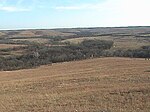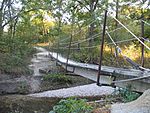Konza Prairie
Geography
Konza Prairie is located within the largest remaining area of unplowed tallgrass prairie in North America, the Flint Hills. It is located approximately 10 kilometres (6.2 mi) south of Manhattan, Kansas and its southern boundary parallels Interstate 70. A scenic overlook exists on the preserve's eastern boundary along K-177.
The site is topographically complex with an elevation range from 1050 to 1457 ft (320 to 444 m). In addition to the dominant tallgrass prairie, Konza contains forest, claypan, shrub and riparian communities. Limestone outcrops are found throughout the landscape.
Climate
It has a continental climate characterized by warm, wet summers and dry, cold winters. Average annual precipitation (32.9 in, 835 mm) is sufficient to support woodland or savanna vegetation; consequently, drought, fire and grazing are important in maintaining this grassland.
Flora and fauna
The vegetation of Konza Prairie is dominated by native tallgrass which can reach over 2.5 metres in height in the most productive years. The prairie is dominated by plants adapted to the continental climate, mainly perennial grasses such as big bluestem (Andropogon gerardii), little bluestem (Andropogon scoparius), Indiangrass (Sorghastrum nutans), and switchgrass (Panicum virgatum). The grassland habitats include upland prairie on thin loess soils, hill prairie along alternating limestone benches and slopes, and areas of lowland prairie on deep alluvial-colluvial soils.
Konza supports a diverse mix of species including 576 vascular plants, 31 mammals, 208 bird species, 34 types of reptiles and amphibians, 20 kinds of fish, and over 700 types of invertebrates. Native white-tailed deer and wild turkey are often present in large numbers. A herd of approximately 200 bison graze on 2,400 acres (970 ha) of the hills of the Konza Prairie.
Conservation
The site is operated as a field research station by the Kansas State University's Division of Biology. It is one of 26 sites within the Long Term Ecological Research Network. The site was established to provide a natural laboratory for the study of ecological patterns and processes in native tallgrass prairie ecosystems. Key natural processes that regulate and sustain the tallgrass prairie are periodic fire, ungulate grazing, and a variable continental climate. Thus, these processes are the focus of much of the long-term research. Other research by the Kansas State University includes physiological ecology, population and community ecology of plants, insects, birds and mammals, aquatic ecology, ecosystem and landscape ecology, and grasslands restoration ecology. In 2010, 2.8 miles (4.5 km) of stream channels were cleared of woody plant encroachment. Research has shown that reintroducing bison has long-term benefits as their presence makes the land more biodiverse and resilient to drought.
The biological station provides educational opportunities for students from elementary school to post-graduate level.
Members of the public are allowed onto portions of the Konza Prairie through three loop hiking trails (approximately 2.6, 4.5, and 6 miles).
The Konza prairie was designated a UNESCO biosphere reserve in 1978. It was one of 17 reserves in the United States withdrawn from the programme in June 2017 by request of the U.S. government.
-
The Konza in winter.
-
A Konza walking trail in the fall.
-
This bridge crosses Kings Creek.
See also
References
- ^ "Konza Prairie Biological Station," http://kpbs.konza.k-state.edu/history/, accessed 1 Nov 2017
- ^ "Konza Prairie Site Description".
- ^ UNESCO. "Biosphere Reserves: Konza Prairie". Retrieved September 6, 2018.
- ^ "23 new sites added to UNESCO's World Network of Biosphere Reserves". June 14, 2017. Retrieved September 6, 2018.
- ^ Listing of the known Konza Prairie vascular plants alphabetized by common name.
- ^ NPWRC :: Checklists of the United States
- ^ "The Birds of Konza". Archived from the original on June 9, 2007. Retrieved August 5, 2007.
- ^ "Prairie Research Could Help Farming Become More Resilient, Sustainable". Pulitzer Center. Retrieved March 1, 2021.
- ^ Dome, AJ. "'This is America' | Bison calves in Konza Prairie herd thriving". The Mercury. Retrieved September 20, 2021.
- ^ Llopis-Jepsen, Celia (February 23, 2023). "Climate change threatens the Great Plains, but bison may hold a key to resilience". Iowa Public Radio. Retrieved March 1, 2023.
- ^ Hatfield, Kimberly (May 6, 2024). "Kansas Prairie Streams Are Getting Choked, Maybe for Good". Eos. Retrieved May 6, 2024.
- ^ McGinn, Miyo (September 2, 2022). "Bison are bringing biodiversity back to Kansas prairie land". Popular Science. Retrieved September 6, 2022.
- ^ Llopis-Jepsen, Celia (November 16, 2022). "Climate change threatens the Great Plains, but bison may hold a key to resilience". KCUR 89.3. Retrieved January 5, 2023.
- ^ McGlasson, Rachel (January 2, 2024). "Study reveals the surprising superpower of America's bison population: 'Truly unique and impressive'". Yahoo Life. Retrieved January 3, 2024.
![]() This article incorporates text from a free content work (license statement/permission). Text taken from UNESCO - MAB Biosphere Reserves Directory, UNESCO, UNESCO.
This article incorporates text from a free content work (license statement/permission). Text taken from UNESCO - MAB Biosphere Reserves Directory, UNESCO, UNESCO.


